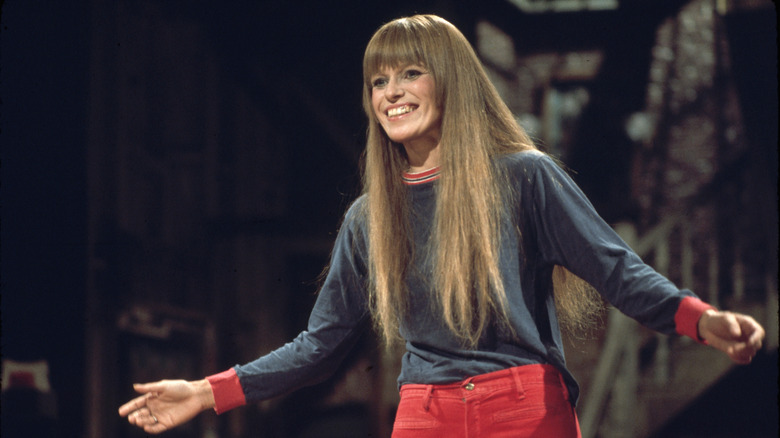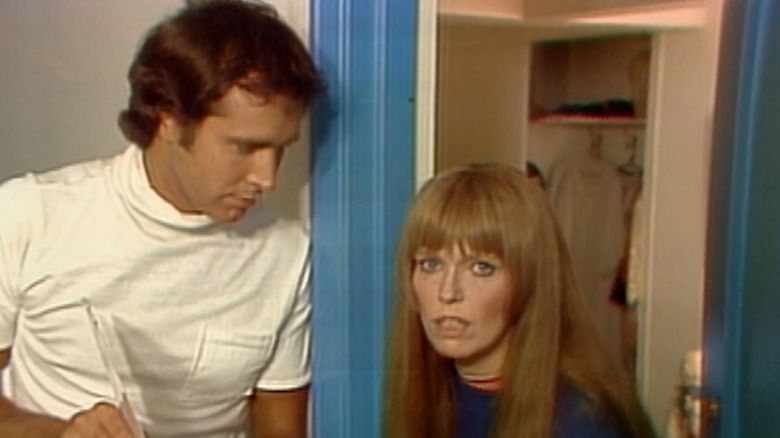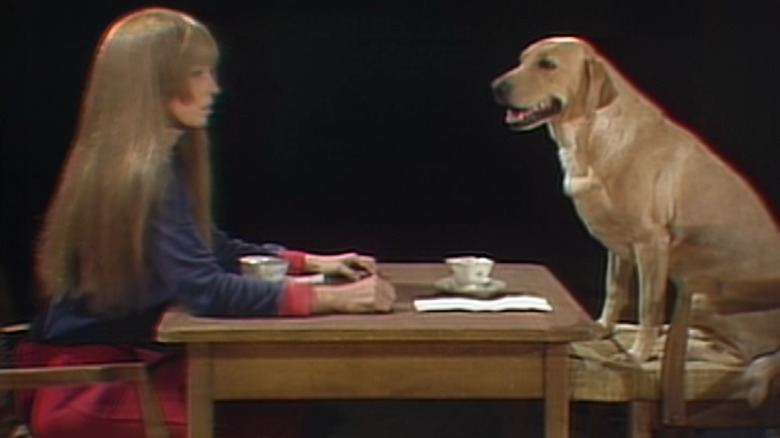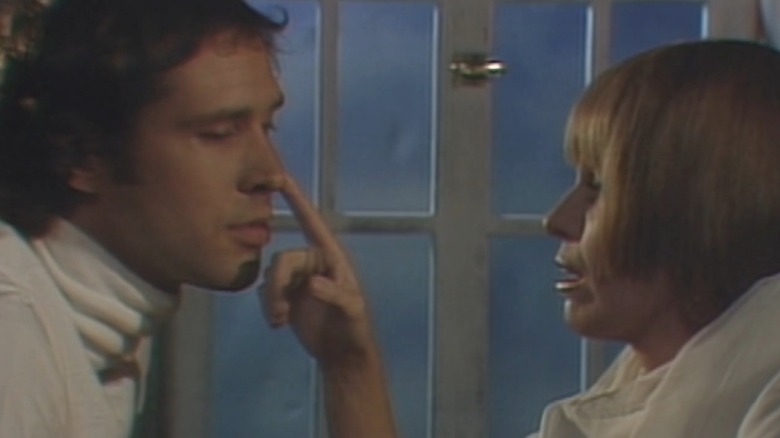Louise Lasser's SNL 'Breakdown' Was All Part Of The Plan
We may receive a commission on purchases made from links.
We may receive a commission on purchases made from links.
Although "Saturday Night Live" has never officially banned a host from returning, there are a handful of one-time hosts who fans think were put on showrunner Lorne Michael's blacklist. There's Adrien Brody and his horrendous Jamaican impression, Steven Seagal and everything about him, and then there's Louise Lasser, for supposedly having a breakdown during her live monologue during the 23rd episode of the show's first season back in 1976.
Lasser, who was famous for playing the lead role in the satirical series "Mary Hartman, Mary Hartman," mentioned early into her monologue that she was nervous, and boy, did it show. For the next few minutes, she repeatedly trailed off, stumbled over her words, and grew increasingly agitated. At one point, she corrected a mistake on the cue cards and talked about it for awhile, a move that signaled to the confused audience that she'd gone fully off-script.
This monologue, especially on first watch when you're not sure what's going on, will stress you out. There's none of the usual security that comes with knowing you're watching a seasoned performer, and it feels like she might run off the stage at any moment — and that's exactly what she does. Yes, she apologizes and walks off, hiding herself in her dressing room as other cast members (Gilda Radner, Chevy Chase) try to talk her back into hosting the show.
For savvy viewers, it's clear the moment the cameras follow her backstage that this is all a planned bit. As one critic noted the next day, "Television can't move that fast; 'live' doesn't mean unpremeditated." But the reason for the confusion is clear: The build-up to Lasser's breakdown is slow, awkward, and convincing. It may remind modern fans of the 2017 "SNL" sketch "Late for Class," in which it was unclear at first if new cast member Luke Null was bombing or if his character was supposed to feel stiff. Intentionally bad acting can be fun to watch, but only if we know it's intentional. But in this case, at least we know it was all part of the plan.
Louise Lasser has confirmed the monologue was all planned
The monologue, which is not posted on the show's official YouTube page but can be found on Peacock and the DVD collections of the early seasons, was not well-received. "Saturday Night Dull," one critic declared about the episode. (This sort of pun was still considered fresh at the time.) Unlike many viewers, most critics understood the meta nature of that opening monologue, but that still didn't help its case. One tongue-in-cheek write-up of the episode quipped, "Ambitious failure is a special talent. Only the brave can fail abysmally."
Lasser herself was asked about the monologue in a 2013 interview. The interviewer seemed surprised to hear the whole thing was planned and pointed out to her the rumors that showrunner Lorne Michaels despised the whole bit, and he even had the episode pulled from reruns out of anger. There is some truth to these stories: The episode was indeed pulled from NBC reruns and some cast members did find Lasser annoying, but as always, the real story is more complicated.
"[Michaels] struck [the episode] because my manager said strike it. [My manager] didn't like the whole episode," Lasser explained. She and Michaels, meanwhile, were on good terms. "You know, it's on Wikipedia that I was banned from that show, but it's not true. I was so hurt. He had invited me to come back; he said come back in two weeks and do another show," said Lasser.
She elaborated a bit more on her relationship with Lorne Michaels, "About six months later we were at [Elaine May's] with some people, and he [Michaels] said, 'You know, it's only now occurring to me how much pressure you were under at that time,' which is interesting, because it was true. It's like everything came up at once."
The Louise Lasser SNL episode was weird all around
This was indeed a uniquely stressful time in Lasser's life. Shortly before hosting, she was arrested for possession of cocaine, an incident that the tabloids covered breathlessly. She was also suffering from exhaustion and pressure from her chaotic work schedule, and both negatively impacted her week on "SNL."
"I was sort of falling apart," she said in that same 2013 interview. "Everything got tarnished for me, and I couldn't find my way, and I didn't enjoy acting anymore." Other members of the "SNL" crew have spoken, often harshly, about how she was in a bad place that week. Head writer Michael O'Donoghue called her "clinically berserk" in "Saturday Night: A Backstage History of Saturday Night Live," and writer Neil Levy alleged in "Live from New York" that she'd been "on her hands and knees crawling into my office looking for pot" in the days before the live taping.
These anecdotes have only added to the confusion over how much of that monologue was planned. Making it seem even more real was how Lasser was oddly absent throughout the rest of the show and doesn't interact with other cast members much in the sketches she's in. Her last sketch is one where she monologues yet again, seemingly off-script in a way that Lorne Michaels famously disapproves of. She's also in an Ingmar Bergman parody sketch that gets tepid laughs, and she has a conversation with a dog that goes on for way too long.
Lasser's absence was most clearly felt in a risqué sketch starring cast members Jane Curtin and Gilda Radner, where the two talk about male genitalia for several minutes straight. "I just didn't like those kinds of sketches," Lasser explained. "I don't know. It was really weird. They had a lot of meetings in my house in California, and they told me I'd be allowed to write, and none of that was true."
Lasser's refusal to go through with that sketch, and the show's insistence on her doing it, nearly killed the episode before they had Curtin take her place. "At the last minute, my manager said they're not going to cut it. So I said, 'Then I'm going to go,'" Lasser explained. "And he said, 'Are you serious, you're going to make an ultimatum out of this?' And I said, 'I think so.'"
However, Louise Lasser's performance is better in hindsight
The most damaging part of this "SNL" episode to Lasser's career was how it contributed to her image as a difficult actress to work with, a liability to have on set. Not only was the episode poorly received and pulled from reruns, but Chevy Chase badmouthed her to the press almost immediately after the credits rolled.
"Chevy Chase, the normally low-keyed star of NBC's 'Saturday Night' comedy show, is telling people that he had to restrain himself while working with Louise Lasser, star of 'Mary Hartman, Mary Hartman,'" the Detroit Free Press reported. "After the filming was over, Chase called her 'the largest bleepity blank I've ever had the misfortune of working with.' The complaint against Louise isn't unique; she's had problems getting along with some of the cast members on her own soap opera spoof."
As the years went on and the mountain of famous anecdotes about Chase being a jerk behind-the-scenes grew, the sting of his criticism of Lasser lessened. It's grown easier to believe Lasser's account of the situation. "He was so mean to me, really mean, like-a-bully mean," she said about Chase. "And I didn't understand it. I was seeing the guy who was the script supervisor. He couldn't believe what was going on there."
Helping Lasser's case is that the monologue, despite how stressful it is on first watch, is still the strongest bit of the episode. It's bold, experimental, memorable, and filled with fun illusions to "Mary Hartman, Mary Hartman." Lasser had a lot of creative control over her own TV show but was not allowed to write much for "SNL." The fact that her monologue was the one bit she had a say over, and that it's the only bit to feel unique and interesting, implies that it was the "SNL" writers who let down Lasser, not the other way around.



